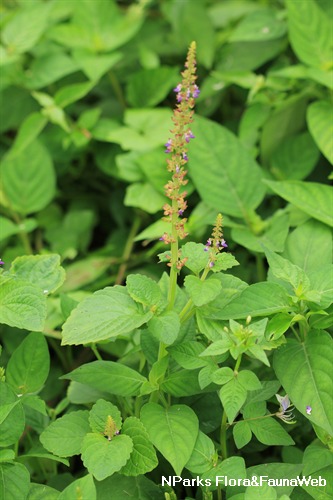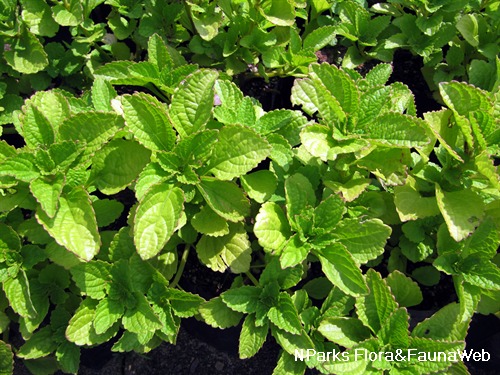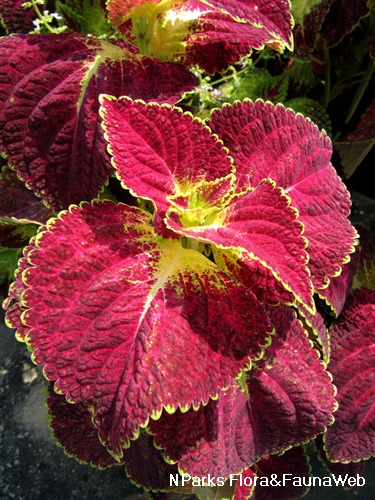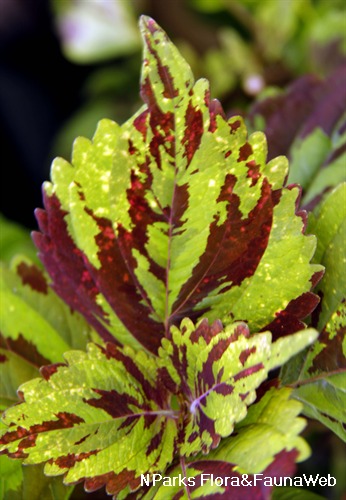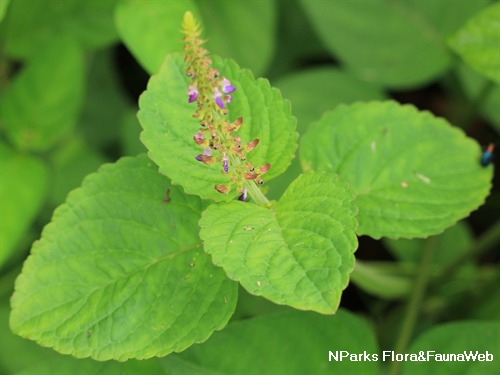
Back
Coleus monostachyus (P.Beauv.) A.J.Paton
| Family Name: | Lamiaceae (Labiatae) |
| Synonyms: | Ocimum monostachyum P.Beauv., Plectranthus monostachyus (P.Beauv.) B.J.Pollard, Plectranthus palisotii Benth., Solenostemon monostachyus (P.Beauv.) Briq. |
| Common Name: | Monkey's Potato |
Name
Classifications and Characteristics
| Plant Division | Angiosperms (Flowering Seed Plants) (Dicotyledon) |
|---|---|
| Plant Growth Form | Herbaceous Plant |
| Lifespan (in Singapore) | Annual |
| Mode of Nutrition | Autotrophic |
| Plant Shape | Shrubby |
| Maximum Height | 0.3 m to 1 m |
Biogeography
| Native Distribution | Western Tropical Africa to Sudan |
|---|---|
| Native Habitat | Terrestrial |
| Preferred Climate Zone | Tropical |
| Local Conservation Status | Non-native (Spontaneous (Naturalised)) |
Description and Ethnobotany
| Growth Form | Erect, typically annual herb up to 1 m tall. Occasionally, it can be perennial. |
|---|---|
| Foliage | Light green, egg-shaped leaves are lined with rounded teeth on the leaf margin. |
| Flowers | The 2-lipped, purple and white flowers are arranged in small clusters of 3-5 known as cymes. The cymes are arranged in whorls (known as verticils) along a spike inflorescence. |
| Fruit | The fruit is composed of 4 egg-shaped nutlets (1 mm wide). |
| Similar | Monkey's Potato resembles Indian Borage (scientific name: Coleus amboinicus), but it has a distinctly 4-sided stem, while that of Indian Borage is more round. |
| Cultivation | In Singapore, this species is not cultivated and generally considered a weed. |
| Ethnobotanical Uses | Edible Plant Parts : Edible Leaves Food (Fruit or Vegetable): In Africa, the leaves are boiled as a vegetable. Medicinal: Traditional Medicinal Uses According to traditional medicine, the leaf sap is taken internally for fever, cough, headache, colic and convulsions. It is thought to have a calming, sedative effect, as well as improving appetite and strengthening the stomach. It is important to note that some therapeutic effects from traditional medicinal uses of plants are not currently supported or verified by scientific research. Cultural / Religious: In Africa, this species is used in rituals related to pregnancy. |
Plant Care and Propagation
| Light Preference | Full Sun |
|---|---|
| Water Preference | Moderate Water |
| Plant Growth Rate | Fast |
| Maintenance Requirements | Low |
| Propagation Method | Seed, Stem Cutting |
Foliar
| Foliage Retention | Evergreen |
|---|---|
| Mature Foliage Colour(s) | Green |
| Mature Foliage Texture(s) | Bulging in between Veins |
| Foliar Type | Simple / Unifoliate |
| Foliar Arrangement Along Stem | Opposite |
| Foliar Attachment to Stem | Petiolate |
| Foliar Shape(s) | Non-Palm Foliage (Ovate) |
| Foliar Venation | Pinnate / Net |
| Foliar Margin | Crenate |
| Foliar Apex - Tip | Acute |
| Foliar Base | Rounded / Obtuse, Truncate / Square |
| Typical Foliar Area | Mesophyll ( 45cm2 - 182.25 cm2 ) |
| Typical Foliar Size | 6 cm to 13.5 cm |
Floral (Angiosperm)
| Flower & Plant Sexuality | Bisexual Flowers |
| Flower Colour(s) | Purple, White |
|---|---|
| Flower Grouping | Cluster / Inflorescence |
| Flower Location | Terminal |
| Flower Symmetry | Bilateral |
| Individual Flower Shape | Labiate / Lipped |
| Inflorescence Type | Cyme, Verticel, Spike |
| Flowering Habit | Polycarpic |
| Flower Size | 1 cm |
Fruit, Seed and Spore
| Mature Fruit Colour(s) | Brown |
|---|---|
| Mature Fruit Texture(s) | Sticky |
| Fruit Classification | Simple Fruit |
| Fruit Type | |
| Seed Quantity Per Fruit | Few (1-5) |
References
| References | <1> Kiew, R., Kamin, I. (2021) Coleus (Lamiaceae) in Peninsular Malaysia including two new species. PhytoKeys 186: 93-110. |
|---|
Image Repository
Others
| Master ID | 31802 |
|---|---|
| Species ID | 6202 |
| Flora Disclaimer | The information in this website has been compiled from reliable sources, such as reference works on medicinal plants. It is not a substitute for medical advice or treatment and NParks does not purport to provide any medical advice. Readers should always consult his/her physician before using or consuming a plant for medicinal purposes. |

